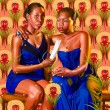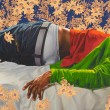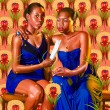The Brooklyn Museum’s “A New Republic” showcases 60 pieces from Wiley’s cohesive body of work, spanning 14 years of excellence and creativity.
Regardless of the series, each of Wiley’s pieces have maintained relevance throughout the years with their independent, yet interconnected focus on race, gender and politics. By transposing African Americans and hip hop cultural motifs into traditionally Caucasian-dominated Renaissance portraiture, Wiley highlights the absence of color and race throughout European artwork, history, and aristocracy.
A few of Wiley’s paintings such as Napoleon Leading The Army Over The Alps from the 2005 “Rumors of War” series and The Sisters Zénaïde and Charlotte Bonaparte from the 2014 series “The World Stage Haiti” are satirical pastiches of works by the Old Masters. Independent curator Tumelo Mosaka says Wiley reassigns value to the sitter and highlights the absence of black leaders such as Martin Luther King Jr and Nelson Mandela from a majority of art history, in regards to Napoleon. When viewing these pieces and many of Wiley’s portraits, one can see the gradation of the ornate baroque background onto the foreground, possibly as Wiley’s attempt to reconcile the history of aristocratic disregard, alienation and colonization with its impact on constructing Black identity, whether it be African American or Hatian.
To be completely consumed by the great scale and eroticism of a piece such as Femme piquée par un serpent is an experience unlike any other. From the 2008 collection “Down”, this enormous masterpiece references Auguste Clésinger’s scandalous sculpture of a naked woman writhing with pain after being bitten by a poisonous snake. Viewing the intricacies and details of the subject juxtaposed by his relationship with the ornate background is watching a conflict unfold. The nudity and vulnerability of the woman replaced by an African American man, with sagging pants and a snapback raises the question “Is today’s underdog oppressed because of gender or race?”
From his 2001 residency at the Studio Museum in Harlem to his most recent pieces on display at the Brooklyn Museum, Kehinde Wiley has come a long way and continues to re-imagine and renegade the conventions of a non-inclusive and colorless Western art history. Don’t miss out on your chance to see the full range and scope that Mr. Wiley has to offer while he’s at the Brooklyn Museum.
-Nishat Baig




